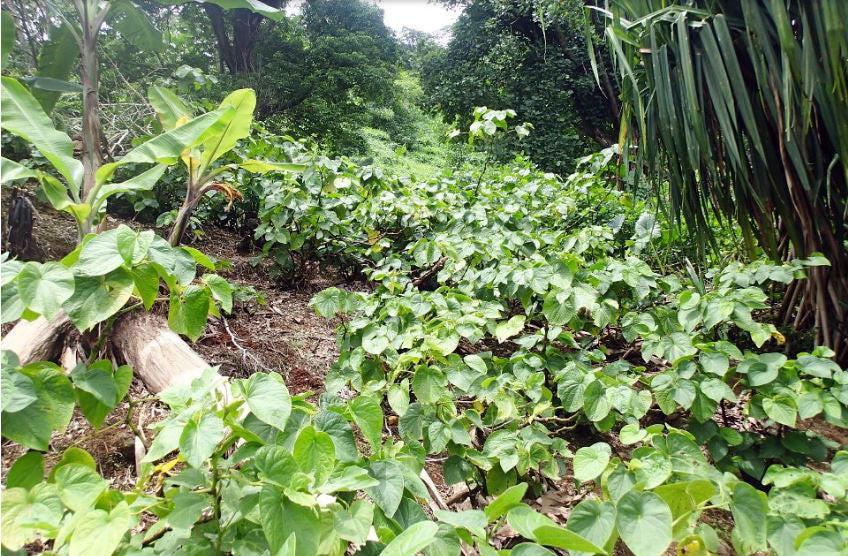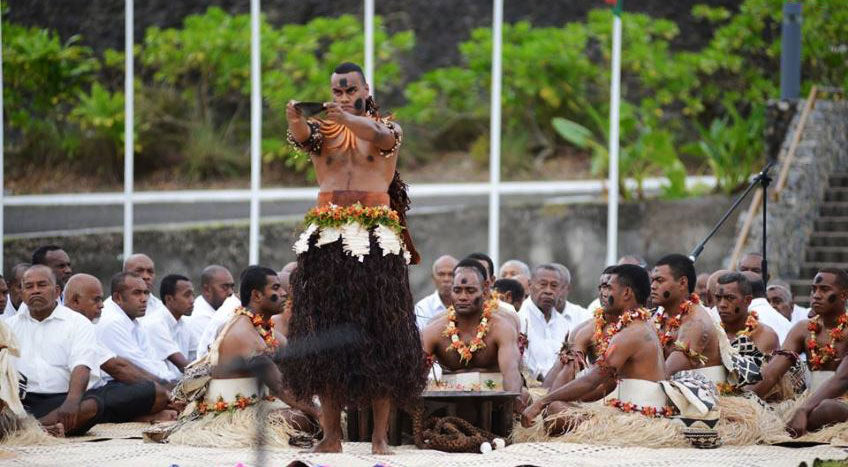Fijian Kava Guide
What is Kava?
Kava is a non alcoholic beverage made from the ground roots of dried/fresh piper methysticum plants. These plants are primarily grown in the South Pacific.
It has been consumed for medicinal, cultural and social purposes throughout the islands of the South Pacific for over 3000 years. The plant thrives in loose, well drained soils where plenty of air can reach the roots and is typically harvested after 4 years of age.
The roots of the plant are commonly dried and grounded into powder form. The powder is then wrapped in a fine porous cloth and kneaded in luke warm water to produce a tanned beverage.
Whats so special about Kava?
Kava has been historically used in the South Pacific as a herbal drink.

What is the Importance of Kava to Fiji?
Kava, locally referred to as Yaqona, is a Fijian link to the past, a tradition so inextricably woven into the fabric of culture that life without it is unimaginable. Fijians would scarcely be Fijians without their national beverage. It is consumed ritually when welcoming visitors, sending village members on journeys, christening boats, laying the foundations of homes, making deals, settling arguments and, as is usually the case, socializing.
It is also presented as a "Sevusevu", a traditional gift offered by guests to the host, or as a token of respect to visitors of higher ranking official ceremonies. Kava has been factored as a reason why Fijians are always happy and why Fiji is considered to have one of the most happiest populous in the world.
What varieties of kava are grown in Fiji?
Fiji grows only 13 varieties of kava. All of the kava strains are noble. Unlike Vanuatu and Hawaii, Fiji does not grow any "tudei" kava which can be very bad for your health. Each of the 13 varieties contain different proportions of kavalactones, which simply means that their effects can vary on its consumer. They also have unique locals names in the region where they are farmed. The key to drinking kava is to experiment with different strains to figure out which one works towards an individual's desired effects. Below are the 13 different varieties and descriptions on how to identify them in Fiji.
1) Yalu
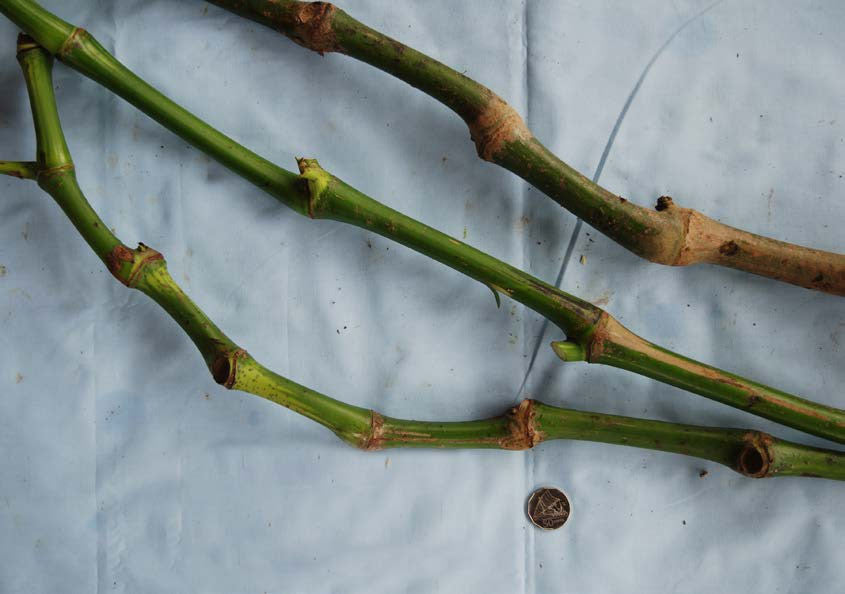
The stems are dark green with either no or very few visible lenticels. Lenticels are brown and may be seen below the upper node on internodes. Some dark green lenticels may be seen in areas where there is chlorosis on the stem. The absence of lenticels means that the stem is smoother to touch than other varieties. The internodes are usually short. The very low number of lenticels and dark green colouration of the stem are key features of this kava type. Yalu was found to be cultivated on Vanua Levu, Viti Levu and Kadavu. Local names used to describe Yalu include: Badrau (on Vanua Levu), Karawa (on Viti Levu) and Mocikawa (on Kadavu).
2) Yonolulu

The stems are green with few large green lenticels that occur in the top two thirds of the internode. The small number of lenticels means that the stems feel relatively smooth. Some dark green colouration may be seen above the lower node of the internode. The internodes are usually short and thick. The small number of green lenticels near the top of the internode is a key characteristic of this kava type. The short internode length distinguishes Yonolulu from Qila balavu. Yonolulu was found to be cultivated on Kadavu, Viti Levu and Vanua Levu and Ovalau. Local names used to describe Yonolulu include: Mocikawa (on Kadavu), Karawa (on Kadavu and Viti Levu), Matanitabua (on Vanua Levu) and Leka (on Ovalau).
3) Qila Balavu
The stems are green with few lenticels which occur mainly in the top two thirds of the internode. The lenticels are a darker green than the surrounding stems and often have raised brown centres. The size of the dark colouration around lenticels varies between plants. Some dark green colouration or striping may be seen above the lower node of the internode in some plants. The internodes are generally long. The small number of green lenticels near the top of the internode is a key characteristic of this kava type. The long internode length distinguishes Qila balavu from Yonolulu. Qila balavu has been observed being cultivated on Viti Levu and Taveuni. Local names used to describe Qila balavu include: Dakua (on Viti Levu), Dokobana vula, and Badrau (on Taveuni).
4) Damu
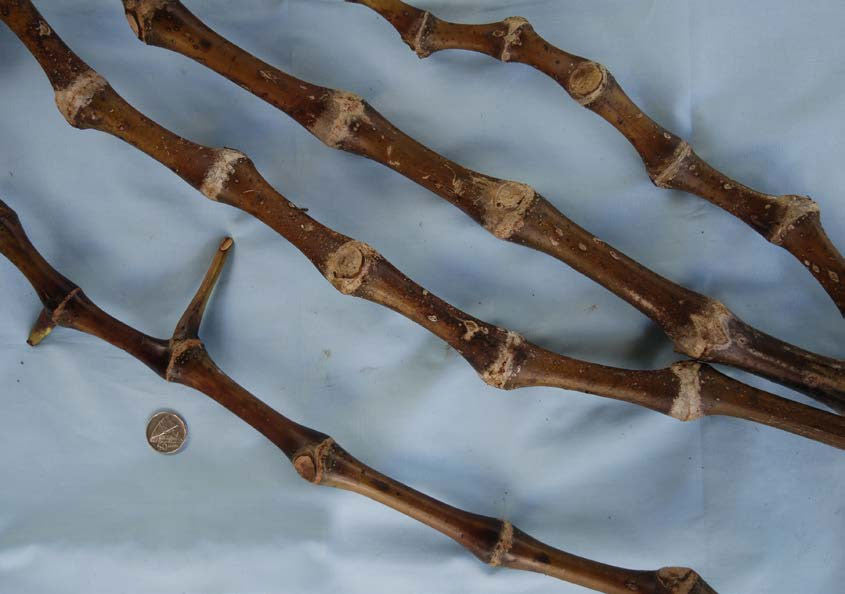
The stems have very few lenticels, occurring mainly in the top third of each internode, and the stems exhibit some purple colour. Colouration in the internode varies between plants, from mainly green through to dark purple. Colour in the internode is darkest above the lower node and becoming lighter towards the top of each internode. Lenticels are purple and often with raised brown coloured centres. Internodes vary in length and are often short and thick but may be long. This kava type is distinguished by the relatively low number of dark or purple coloured lenticels on their internodes and the purple pigmentation in the stems. Damu is cultivated on Vanua Levu, Ovalau, Kadavu and Taveuni. Local names used to describe Damu include: Damu (on Vanua Levu, Taveuni, and Ovalau), Kasa Damu (on Vanua Levu), Yalu (on Taveuni), and Kasakasa Kula (on Kadavu).
5) Qila Leka

The stems are green with very fine, slightly darker green, striations running lengthwise along the node. The stems have many lenticels which are less well defined shape than in other kava varieties. The lenticels are the same green colour as the striations, are raised and may have brown centres. The internodes are generally short. The green striations, less well defined lenticels and relatively short internodes are key characters of this type of kava. Qila leka has been observed being cultivated on Kadavu, Vanua levu, Taveuni and Ovalau. Local names used to describe Qila leka include: Qereqere (on Kadavu), Qere (on Kadavu), Qila leka (on Vanua levu), Qila (on Vanua levu), Kasa Naloto (on Vanua levu), Dokobana vula (on Vanua levu), Qila (on Taveuni) and Bisinisi (on Ovalau).
6) Vula Kasa Leka

The stems are pale green with many small dark green lenticels spread over the length of each internode. The internodes are usually short and the stems are generally thick, with
pronounced nodes and a narrow “waist” in the internode. The large number of green lenticels is a key character of both Vula kasa leka and Vula kasa balavu. The short length of the internodes is the character that defines Vula kasa leka from Vula kasa balavu, and this distinction can be difficult to make. Vula kasa leka has been observed being cultivated on Vanua levu, Viti levu, Ovalau and Kadavu. Local names used to describe Vula kasa leka include: Bisinisi (on Vanua levu), Vau leka (on Vanua levu), Diria (on Viti levu), Dokobana (on Ovalau) and Karawa (on Kadavu).
7) Vula Kasa Balavu
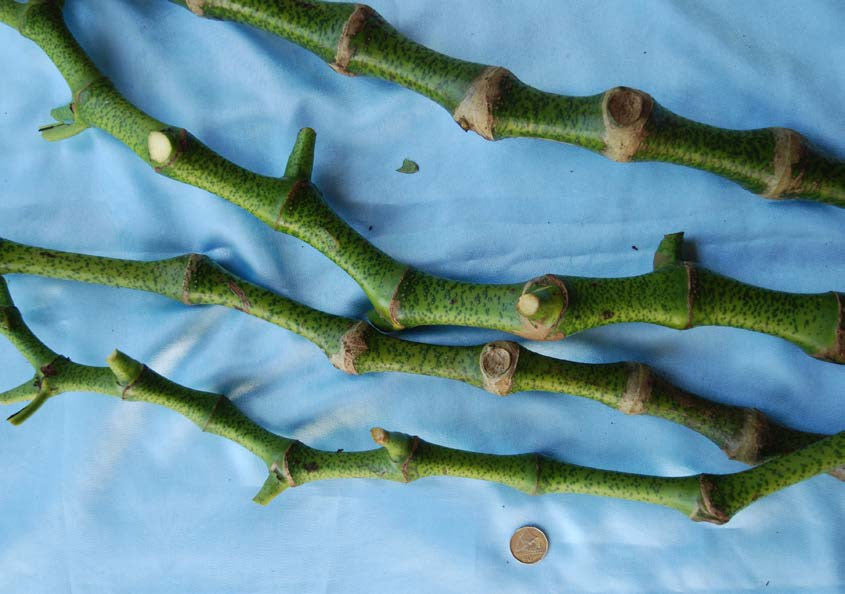
The stems are pale green with many small dark green lenticels spread over the length of each internode. The internodes are generally long and thinner than Vula kasa leka. The large number of green lenticels is a key character of both Vula kasa balavu and Vula kasa leka. The longer length of the internodes is the character that defines Vula kasa balavu from Vula kasa leka, and this distinction can be difficult to make. Vula kasa balavu is cultivated on Viti Levu, Vanua Levu and Taveuni. Local names used to describe Vula kasa balavu include: Diria (on Viti Levu), Vanua (on Viti Levu), Kava vula leka (on Vanua Levu), Dokobana vula balavu (on Vanua Levu) and Taveuni (Dokobana vula).
8) Dokobana Vula
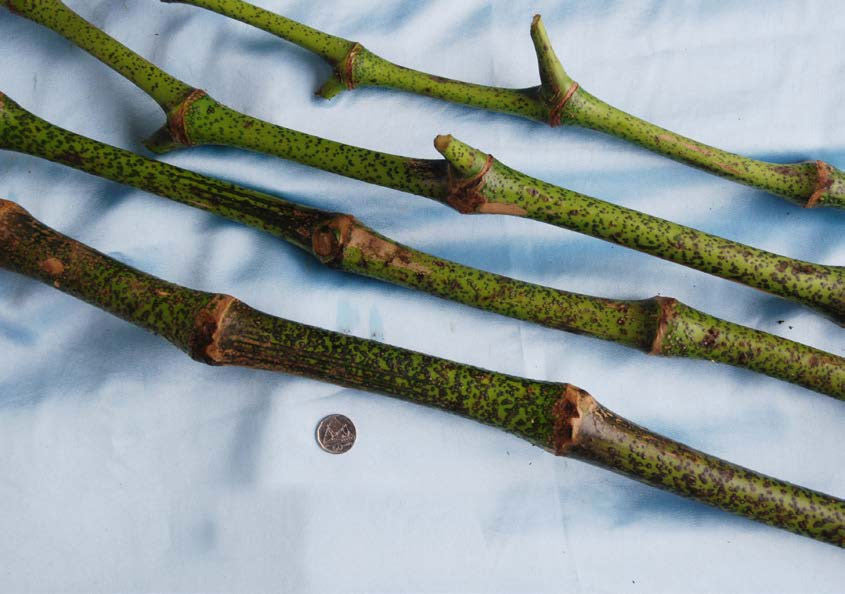
Stems are green with many lenticels over the length of each internode. Lenticels are very dark green in colour, often with raised brown centres. Some dark green, verging towards
purple pigmentation may be seen just above the lower node of internodes. In some plants dark green triangular stripes may develop from the lower node and stretch up towards the upper node of the stem. These stripes may or may not be present and vary in size. Internodes tend to be long. These plants tend to grow above head height, and vary between a spreading and upright habit. Dokobana vula differs from Matakaro leka and Matakaro balavu in that the lenticels tend to be very dark green rather than purple, and that purple pigmentation, if present, is restricted to only a small part low on the internode. Dokobana vula tends to have long internodes like Matakaro balavu. Dokobana vula has been seen cultivated on Vanua Levu, Kadavu and Ovalau. Local names used to describe Dokobana vula include: Dokobana vula (on Vanua Levu), Vula kasa leka (on Vanua Levu), Kasa naloto (on Vanua Levu), Gau (on Kadavu) and Matakaro (on Ovalau).
9) Matakaro Leka

The stems are green with many lenticels spread along the length of the internode. The lenticels tend to be dark purple, but may be green near the top of internodes. The internode tends to be green in colour although some purple colouration may be seen above the lower node of the internode. The internodes are short. Matakaro leka is similar to Loa kasa leka, but Loa kasa leka has purple pigment over the length of the internode whereas Matakaro leka has very little pigmentation if any. Matakaro leka has a very strong colour contrast between the lenticels (very dark, almost purple) and the stem (green). The short internodes are the key point of difference between this kava type and Matakaro balavu which has longer internodes. Matakaro leka has been observed being cultivated on Taveuni, Vanua Levu, Viti levu and Kadavu. Local names used to describe Matakaro leka include: Loa (on Taveuni), Matakaro (on Taveuni), Matakaro leka (on Vanua Levu), Yagona ni koro (on Vanua Levu), Kasa loa leka (on Vanua Levu), Kavoronikaisau (on Vanua Levu), Damu (on Viti levu), Lovoni (on Kadavu) and Bera na vakaco (on Kadavu).
10) Matakaro Balavu

The stems are green with many lenticels spread along the length of the internode. The lenticels tend to be dark purple, but may be green near the top of internodes. The internode tends to be green in colour although some purple colouration may be seen on the internode above the lower node. Internodes are long, and this is the key difference between Matakaro balavu and Matakaro leka. Matakaro balavu is similar to Loa kasa balavu, but Loa kasa balavu has purple pigment over the length of the internode whereas Matakaro balavu has very little pigmentation if any. Matakaro balavu has a very strong colour contrast between the lenticels (very dark, almost purple) and the stem (green). The
long internodes are the key point of difference between this kava type and Matakaro leka which has shorter internodes. Matakaro balavu has been observed being cultivated on Taveuni, Vanua levu, Ovalau and Viti Levu. Local names used to describe Matakaro balavu include: Bisinisi (on Taveuni), Dokobana vula (on Taveuni and Vanua levu), Vula kasa balavu (on Vanua levu), Kasa vula (on Vanua levu), Matakaro balavu (on Ovalau) and Kadavu (on Viti Levu).
11) Dokobana Loa
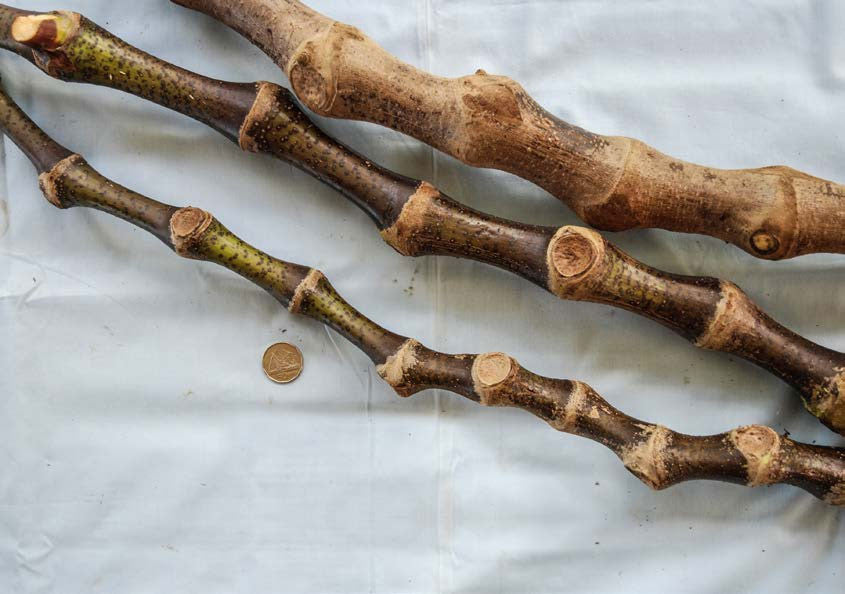
The stems have many lenticels that are distributed evenly over the length of each internode. The lenticels are purple in colour, and the internodes have purple pigmentation which is darkest above the lower node and fades towards the upper node of the internode. The internodes are generally short. Petioles are generally dark red/purple in colour and the point on the leaf where the petiole joins the leaf has some purple colouration. A key characteristic of this kava type is that the purple pigmentation fades below the upper node of the internode so that an area of green stem can be seen below the upper node. The areas of green stem distinguish it from Loa kasa leka and Loa kasa balavu. Dokobana loa has been observed being cultivated on Viti Levu, Kadavu, Vanua Levu and Ovalau. Local names used to describe Dokobana loa include: Damu (on Viti Levu), Loa (on Kadavu and Ovalau), Loa kasa leka (on Vanua Levu), and Loa leka (on Vanua Levu).
12) Loa Kasa Leka
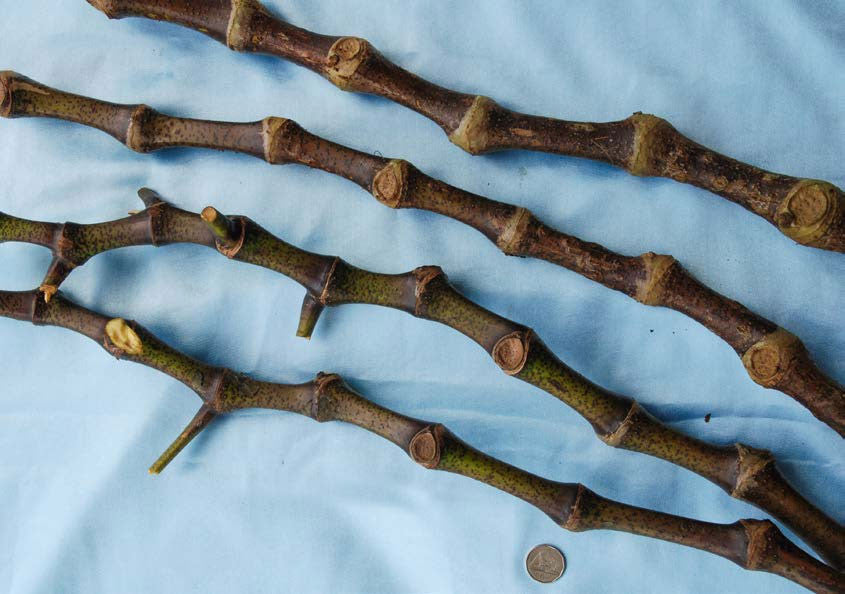
The stems have many lenticels along the length of the internode and are dark purple to black in colour. Lenticels are raised, often with dark brown centres. Some green colour may be seen through the purple pigmentation, but the dark colouration dominates. Petioles are generally dark red/purple in colour and the point on the leaf where the petiole joins the leaf has some purple colouration. The internodes are generally short. Loa kasa leka and Loa kasa balavu are very similar in appearance, but differ in the length of the internodes (Loa kasa leka is shorter). Loa kasa leka has been observed being cultivated on Vanua Levu, Taveuni, Kadavu and Ovalau. Local names used to describe Loa kasa leka include: Matakaro leka (on Vanua Levu), Dokobana loa (on Vanua Levu and Taveuni), Loa kasa leka (on Vanua Levu), Kasa Loa on Vanua Levu) and Loa (on Kadavu and Ovalau).
13) Loa Kasa Balavu
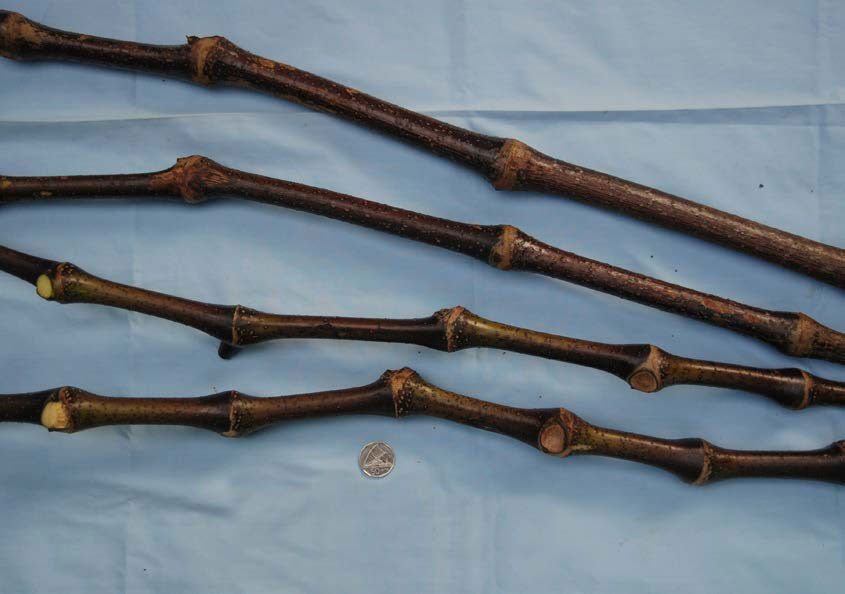
The stems have many lenticels along the length of the internode and are dark purple to black in colour. Lenticels are raised, often with dark brown centres. Some green colour may be seen through the purple pigmentation, but the dark colouration dominates. Petioles are generally dark red/purple in colour and the point on the leaf where the petiole joins the leaf has some purple colouration. The internodes are generally long. Loa kasa balavu and Loa kasa leka are very similar in appearance, but differ in the length of the internodes with loa kasa balavu being longer. Loa kasa balavu has been observed being cultivated on Vanua Levu, Taveuni, Ovalau and Kadavu. Local names used to describe Loa kasa balavu include: Dokobana loa (on Vanua Levu and Taveuni), Loa kasa balavu (on Vanua Levu), Dokobana loa balavu (on Vanua Levu), Loa (on Ovalau and Kadavu) and Kabakabavale (on Kadavu).

